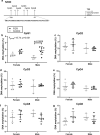Developmental programming in human umbilical cord vein endothelial cells following fetal growth restriction
- PMID: 33256815
- PMCID: PMC7708922
- DOI: 10.1186/s13148-020-00980-9
Developmental programming in human umbilical cord vein endothelial cells following fetal growth restriction
Abstract
Background: Fetal growth restriction (FGR) is associated with an increased susceptibility for various noncommunicable diseases in adulthood, including cardiovascular and renal disease. During FGR, reduced uteroplacental blood flow, oxygen and nutrient supply to the fetus are hypothesized to detrimentally influence cardiovascular and renal programming. This study examined whether developmental programming profiles, especially related to the cardiovascular and renal system, differ in human umbilical vein endothelial cells (HUVECs) collected from pregnancies complicated by placental insufficiency-induced FGR compared to normal growth pregnancies. Our approach, involving transcriptomic profiling by RNA-sequencing and gene set enrichment analysis focused on cardiovascular and renal gene sets and targeted DNA methylation assays, contributes to the identification of targets underlying long-term cardiovascular and renal diseases.
Results: Gene set enrichment analysis showed several downregulated gene sets, most of them involved in immune or inflammatory pathways or cell cycle pathways. seven of the 22 significantly upregulated gene sets related to kidney development and four gene sets involved with cardiovascular health and function were downregulated in FGR (n = 11) versus control (n = 8). Transcriptomic profiling by RNA-sequencing revealed downregulated expression of LGALS1, FPR3 and NRM and upregulation of lincRNA RP5-855F14.1 in FGR compared to controls. DNA methylation was similar for LGALS1 between study groups, but relative hypomethylation of FPR3 and hypermethylation of NRM were present in FGR, especially in male offspring. Absolute differences in methylation were, however, small.
Conclusion: This study showed upregulation of gene sets related to renal development in HUVECs collected from pregnancies complicated by FGR compared to control donors. The differentially expressed gene sets related to cardiovascular function and health might be in line with the downregulated expression of NRM and upregulated expression of lincRNA RP5-855F14.1 in FGR samples; NRM is involved in cardiac remodeling, and lincRNAs are correlated with cardiovascular diseases. Future studies should elucidate whether the downregulated LGALS1 and FPR3 expressions in FGR are angiogenesis-modulating regulators leading to placental insufficiency-induced FGR or whether the expression of these genes can be used as a biomarker for increased cardiovascular risk. Altered DNA methylation might partly underlie FPR3 and NRM differential gene expression differences in a sex-dependent manner.
Keywords: DNA methylation; Developmental programming; Epigenetics; FPR3; Fetal growth restriction; Gene set enrichment analysis; Human umbilical cord vein endothelial cells; LGALS1; NRM; RNA-sequencing; Sex differences.
Conflict of interest statement
The authors declare that they have no competing interests.
Figures



Similar articles
-
Prenatal Sildenafil and Fetal-placental Programming in Human Pregnancies Complicated by Fetal Growth Restriction: A Retrospective Gene Expression Analysis.J Trial Error. 2023 Sep 26:e16. doi: 10.36850/e16. Online ahead of print. J Trial Error. 2023. PMID: 39404670 Free PMC article.
-
Formyl peptide receptor-2 is decreased in foetal growth restriction and contributes to placental dysfunction.Mol Hum Reprod. 2018 Feb 1;24(2):94-109. doi: 10.1093/molehr/gax067. Mol Hum Reprod. 2018. PMID: 29272530
-
Down-regulation of placental neuropilin-1 in fetal growth restriction.Am J Obstet Gynecol. 2016 Feb;214(2):279.e1-279.e9. doi: 10.1016/j.ajog.2015.09.068. Epub 2015 Sep 26. Am J Obstet Gynecol. 2016. PMID: 26409917
-
Conflicting Effects of Fetal Growth Restriction on Blood Pressure Between Human and Rat Offspring: A Meta-Analysis.Hypertension. 2020 Mar;75(3):806-818. doi: 10.1161/HYPERTENSIONAHA.119.14111. Epub 2020 Jan 27. Hypertension. 2020. PMID: 31983304
-
Examining the link between placental pathology, growth restriction, and stillbirth.Best Pract Res Clin Obstet Gynaecol. 2018 May;49:89-102. doi: 10.1016/j.bpobgyn.2018.03.004. Epub 2018 Mar 26. Best Pract Res Clin Obstet Gynaecol. 2018. PMID: 29759932 Review.
Cited by
-
Identification of Key Mitochondrial Autophagy-Related Genes in Fetal Growth Restriction.Int J Womens Health. 2025 May 5;17:1249-1261. doi: 10.2147/IJWH.S510947. eCollection 2025. Int J Womens Health. 2025. PMID: 40351334 Free PMC article.
-
Prenatal Sildenafil and Fetal-placental Programming in Human Pregnancies Complicated by Fetal Growth Restriction: A Retrospective Gene Expression Analysis.J Trial Error. 2023 Sep 26:e16. doi: 10.36850/e16. Online ahead of print. J Trial Error. 2023. PMID: 39404670 Free PMC article.
-
Value of Non-Coding RNA Expression in Biofluids to Identify Patients at Low Risk of Pathologies Associated with Pregnancy.Diagnostics (Basel). 2024 Mar 29;14(7):729. doi: 10.3390/diagnostics14070729. Diagnostics (Basel). 2024. PMID: 38611642 Free PMC article. Review.
-
The Long-Term Effect of Maternal Iron Levels in the Second Trimester on Mild Thinness among Preschoolers: The Modifying Effect of Small for Gestational Age.Nutrients. 2023 Sep 11;15(18):3939. doi: 10.3390/nu15183939. Nutrients. 2023. PMID: 37764723 Free PMC article.
-
Reshaping the chromatin landscape in HUVECs from small-for-gestational-age newborns.JCI Insight. 2025 Apr 22;10(8):e186812. doi: 10.1172/jci.insight.186812. eCollection 2025 Apr 22. JCI Insight. 2025. PMID: 40260916 Free PMC article.
References
Publication types
MeSH terms
Substances
LinkOut - more resources
Full Text Sources
Medical
Research Materials
Miscellaneous

